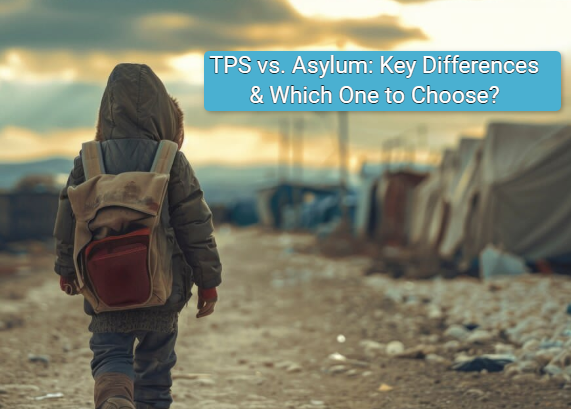Introduction
TPS vs. asylum selection can be complicated since both provide protection but have variations in benefits, qualifications, and long-term solutions. Regardless of whether you are applying for temporary protected status TPS card or thinking about applying for asylum, you need to be aware of these legal safeguards.
This guide offers a complete comparison, covering TPS benefits, asylum qualification, defensive vs. affirmative asylum, and the impact of each status on long-term immigration strategies, including TPS to Green Card routes.
What is TPS? Defining Temporary Protected Status

What Does TPS Mean?
What does TPS mean? TPS, Temporary Protected Status, is a program of humanitarian relief that permits citizens of specific nations to stay in the U.S. because the country is deemed unsafe for their return. TPS program immigration isn’t an official route to Green Card status but offers employment permission and protection from deportation.
Who Can Get TPS?
To be eligible for TPS, you will:
- Belonging to one of the TPS-designated countries.
- Have remained in the U.S. constantly since the established date.
- Not possess serious criminal offenses.
The Biden administration extends the TPS status for nationals from four nations so that protection does not run out. Extension of TPS is not immune to change in government policies, and so it is temporary but worthwhile.
TPS Applications & Processing Time
Apply for TPS via USCIS Form I-821. The procedure consists of:
- Providing proof of identity and ongoing residence.
- Paying application fees (dependent on age and status).
- Waiting for USCIS approval, which may take 6-12 months.
TPS Benefits & Limitations
TPS Benefits:
- Work Authorization: Entitled to an EAD (Employment Authorization Document).
- Protection from Deportation: May not be removed while TPS is in effect.
- TPS Travel Authorization: Permits limited travel with advance parole.
- Access to Driver’s License & Social Security Number.
Limitations of TPS:
- How long is TPS valid for? Generally 6-18 months, with possible extensions.
- No Direct Route to a Green Card except for those who are eligible through TPS to Green Card through employment or TPS to Green Card through marriage.
- Cannot vote (Can people with TPS vote? – No, TPS holders are not U.S. citizens).
What is Asylum? Understanding Asylum Status in the USA
What Does It Mean to Claim Asylum?
What is it to seek asylum? Asylum is a type of protection afforded to those fleeing persecution in their native land because of:
- Race
- Religion
- Nationality
- Political Opinion
- Membership in a specific social group
Those who receive asylum status may stay in the U.S., work legally, and ultimately request a Green Card.
Who Can Apply for Asylum in the USA?
Who qualifies for asylum? Anyone within the U.S. or at a point of entry may apply. As opposed to TPS, asylum isn’t limited to nationality.
Where to File Asylum from the USA
If you are abroad, you cannot apply for asylum in the U.S. directly. You have to apply as a refugee to UNHCR. But once within the U.S., you can apply for political asylum in the USA by submitting Form I-589 to USCIS.
Difference Between Asylum and Refugee Status
- Asylum vs refugee status: Refugees apply from overseas, whereas asylum seekers apply from within the U.S.
- Applying for asylum in the USA entails establishing a well-founded fear of persecution.
Asylum Application Process & Processing Time

How long is an asylum case?
- Affirmative asylum: 6 months – few years (backlogs typical).
- Defensive asylum: Depends upon immigration court scheduling.
After your asylum case is pending, you may apply for work authorization after 150 days.
TPS vs. Asylum: Key Differences & Similarities
| Feature | Temporary Protected Status (TPS) | Asylum |
| Eligibility | Only nationals of designated countries | Open to anyone facing persecution |
| Deportation Protection | Yes, while the status is active | Yes, once asylum is granted |
| Work Authorization | Yes | Yes, after 150 days |
| Travel Rights | Limited, needs TPS travel authorization | Allowed with Refugee Travel Document |
| Path to Green Card | No direct path (TPS to Green Card through family/employment) | Yes, after 1 year of asylum approval |
| Risk of Losing Status | High (if TPS designation ends) | Low (unless asylum is denied) |
| Application Deadline | Limited to designated periods | Must apply within 1 year of entering the U.S. |
Pathways from TPS to Green Card: Can a TPS Holder Apply for a Green Card?
Numerous TPS holders ask, Can a TPS holder apply for Green Card? The answer is based on specific situations. TPS, unlike asylum, does not guarantee permanent residency, but there are certain TPS adjustment of status options available.
1. TPS to Green Card Through Employment
TPS to Green Card through employment is feasible if:
- The TPS beneficiary has an employer who is ready to sponsor them.
- The employer submits PERM labor certification and Form I-140 (Employment-Based Immigrant Petition).
- If the TPS beneficiary has had continuous lawful status or is eligible for an exception under Matter of Z-R-Z-C.
Key Challenge: Certain TPS beneficiaries are required to depart the U.S. for consular processing, which poses risks.
2. TPS to Green Card Through Marriage
TPS to Green Card via marriage is among the most frequent paths:
- A TPS beneficiary marries a Green Card holder or U.S. citizen.
- They submit Form I-130 (Petition for Alien Relative) and Form I-485 (Adjustment of Status).
- If eligible, they receive a Green Card without having to leave the U.S.
Main Challenge: Those who entered illegally must request a waiver before adjusting their status.
3. TPS and Adjustment of Status: Can TPS Holders Obtain a Green Card?
While TPS alone will not qualify for a Green Card, it might protect individuals as they consider adjustment of status alternatives.
Travel Rights for TPS & Asylum Holders

1. Where Am I Allowed to Travel With TPS?
Where am I allowed to travel with TPS? TPS recipients require TPS travel authorization (Advance Parole) to travel and return to the U.S.
- TPS holders will lose their status if they don’t have Advance Parole.
- Only travel to countries that will not interfere with your eligibility.
- Going back to your home country can be viewed as a sign that you no longer require TPS.
2. Can I Travel With TPS Status?
Can I travel with TPS status? Yes, but you have to apply for travel authorization TPS using Form I-131.
Warning: Some TPS holders who traveled before to the Matter of Z-R-Z-C decision might be eligible for TPS and adjustment of status if they re-entered legally.
3. Travel Restrictions for Asylum
- Asylum applicants should not travel to their native country while their asylum case pending.
- Asylees should travel on a Refugee Travel Document (RTD) rather than their native country’s passport.
Which One Should You Choose? TPS vs. Asylum Decision Guide
1. Factors to Consider
| Factor | TPS | Asylum |
| Best for… | Individuals from TPS-designated countries | Persecution victims |
| Work Permit? | Yes | Yes (after 150 days) |
| Path to Green Card? | Indirect (Marriage/Employment) | Yes (after 1 year) |
| Deportation Protection? | Yes | Yes |
| Travel Allowed? | With Advance Parole | With Refugee Travel Document |
| Risk of Losing Status? | High (if TPS is terminated) | Low (if asylum granted) |
| Legal Complexity | Moderate | High (needs solid proof) |
2. Situational Recommendations
- If you are from a TPS-designated country, TPS can be the safest short-term solution.
- If you are facing persecution, asylum can be the preferable long-term solution.
- If both options are available, consult a lawyer to determine the best approach.
Secure Your Future with Expert Immigration Guidance

In need of expert immigration advice? Our skilled lawyers at Passage Law are experts in TPS, asylum, Green Card petitions, and adjustment of status.
Find personalized legal advice to guide your immigration process confidently. Consult us today!







